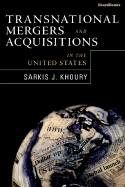|
|
|
|
||||||

|
Transnational Mergers and Acquisitions in the United States By Sarkis J. Khoury 2002/11 - Beard Books 1587981505 - Paperback - Reprint - 314 pp. US$34.95 Khoury's conclusions have stood the test of time: foreign firms operating in the United States have generally had a positive effect on the economy, and from a policy perspective there is no compelling reason to restrict their activities. Publisher Comments When Transnational Mergers and Acquisitions in the United States was first published in 1980, it met a growing need for analytical and empirical data on the burgeoning flow of foreign investment money into the United States due to the foreign acquisition of American firms. Sarkis Khoury examines the motives behind these transnational acquisitions and how foreign firms plan, evaluate, and negotiate mergers in the U.S. With keen insight, he studies the effects of these acquisitions on competition, money and capital markets, the balance of payments, economic policies, the technological position of the U.S., and the operations of the acquired companies. From Turnarounds and Workouts, Vol. 17 No. 17 July/August 2003 Transnational Mergers and Acquisitions in the United States will appeal to a wide range of readers. Dr. Khoury's analysis is valuable for managers involved in transnational acquisitions, whether they are acquiring companies or being acquired themselves. At the same time, he provides a comprehensive and large-scale look at the industrial sector of the U.S. economy that proves very useful for policy makers even today. With its nearly 100 tables of data and numerous examples, Khoury provides a wealth of information for business historians and researchers as well. Until the late 1960s, we Americans were confident (some might say smug) in our belief that U.S. direct investment abroad would continue to grow as it had in the 1950s and 1960s, and that we would dominate the other large world economies in foreign investment for some time to come. And then came the 1970s, U.S. investment abroad stood at $78 billion, in contrast to only $13 billion in foreign investment in the U.S. In 1978, however, only eight years later, foreign investment in the U.S. had skyrocketed to nearly #41 billion, about half of it in acquisition of U.S. firms. Foreign acquisitions of U.S. companies grew from 20 in 1970 to 188 in 1978. The tables had turned an Americans were worried. Acquisitions in the banking and insurance sectors were increasing sharply, which in particular alarmed many analysts. Thus, when it was first published in 1980, this book met a growing need for analytical and empirical data on this rapidly increasing flow of foreign investment money into the U.S., much of it in acquisitions. Khoury answers many of the questions arising from the situation as it stood in 1980, many of which are applicable today: What are the motives for transnational acquisitions? How do foreign firms plans, evaluate, and negotiate mergers in the U.S.? What are the effects of these acquisitions on competition, money and capital markets; relative technological position; balance of payments and economic policy in the U.S.? To begin to answer these questions, Khoury researched foreign investment in the U.S. from 1790 to 1979. His historical review includes foreign firms' industry preferences, choice of location in the U.S., and methods for penetrating the U.S. market. He notes the importance of foreign investment to growth in the U.S., particularly until the early 20th century, and that prior to the 1970s, foreign investment had grown steadily throughout U.S. history, with lapses during and after the world wars. Khoury found that rates of return to foreign companies were not excessive. He determined that the effect on the U.S. economy was generally positive and concluded that restricting the inflow of direct and indirect foreign investment would hinder U.S. economic growth both in the short term and long term. Further, he found no compelling reason to restrict the activities of multinational corporations in the U.S. from a policy perspective. Khoury's research broke new ground and provided input for economic policy at just the right time.
|
|||||||||||||||||||||||||||||||||||||||||||||||||||||||||||||||||||||||||||||||||||||
|
|
|
home
| about
us | contact
us | related
sites |